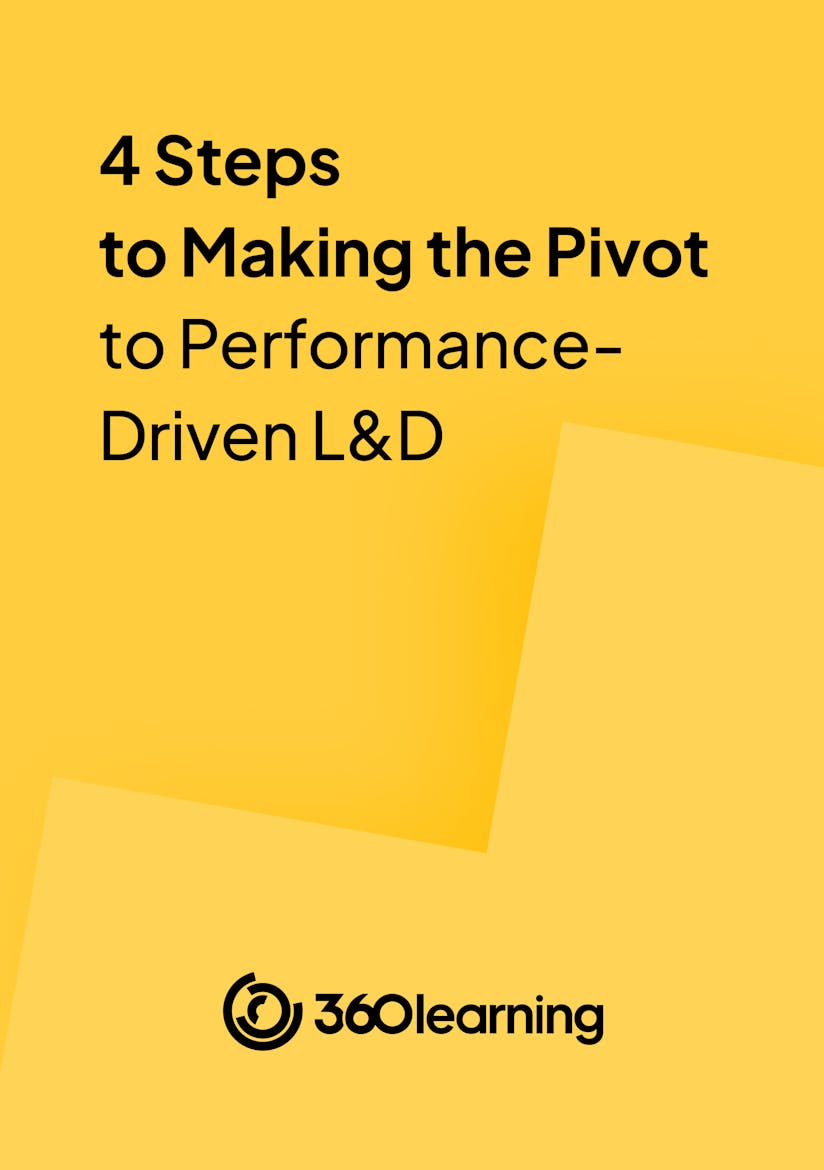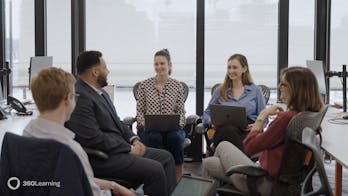
Often in L&D, we believe that if we provide learners with lots of information and make it engaging and interactive enough, we can make an impact.
But this idea falls down fatally because as humans, we forget. We are not designed to remember information that we don't consider important at any given time, and it's unlikely to be remembered when we do need it.
In this recap (check out the full episode here), I speak with Lila Warren, Global Head of Retail Academy at Pret a Manger, about her approaches to impacting performance with learning solutions delivered at the point of need.
Read on to hear about how Lila and her team realized the need to adapt L&D strategy to fit their learners' needs, how they turned challenges into opportunities, and their four-step approach for creating learning that positively impacts performance.
First, let’s explore the turning point that motivated Lila to pivot to performance.
The catalyst for change
The hospitality and retail sectors have been under enormous pressure in recent years, Lila explains, and the effect on L&D has been more significant than ever.
“There was a lot of catching up to do in our industry. Companies are more digitized now,” she says. “And when there's new stuff coming in, it often means that there are new training needs that are going to appear, increasing the demands on L&D.”
Lila and her team recognized the opportunity to improve their approach. “We realized we couldn’t contribute to the pressure by continuing to do the same thing: create content when the learners' context is challenging in the first place,” Lila explains.
“We asked ourselves, ‘Are we solving a problem or contributing to a problem?’ So, it's been really interesting to witness the transformation but also to identify how L&D must be different in how we help the business improve,” she says.
We asked ourselves, ‘Are we solving a problem or contributing to a problem?’ So, it's been really interesting to witness the transformation but also to identify how L&D must be different in how we help the business improve.
But what approach did Lila and her team have before they shook things up?

Impactful, demonstrable L&D in 4 simple steps
By providing your contact info, you agree to receive communications from 360Learning. You can opt-out at any time. For details, refer to our Privacy Policy.
The old days: missing the point of need
Before Lila and the team changed their L&D approach, they focused on creating learning that targeted a learner’s progression path within the company.
“We were looking at different roles and role progression to support the individual with all the learning content that would help them be good at their job,” she says. “But that also meant that many of the training solutions we offered people came at a time when they didn’t need to know the information.”
“Creating training and activating performance are two different things. We can create training content and make it as engaging as possible, but the point of need is extremely important. If I learn something nine months before I need to know it, it's likely that I will forget that information.”
In the past, Lila believes that L&D has been too quick to assume that learners will remember things they learned weeks or months ago, and because they have learned something, they will be good at it.
“But if the performance level is not achieved, if the impact is not the one we expected, then we need to do something different,” she says.
But if the performance level is not achieved, if the impact is not the one we expected, then we need to do something different.
You may be thinking, but hasn’t developing and delivering training and courses always been about solving problems to impact performance?
Here’s why Lila’s intention and approach are different.
Related: Our 2022 Report on the State of Learning in the Flow of Work
When things don’t go to plan
Training is about performance, but in Lila’s experience, it’s when things don't go to plan that L&D teams can really uncover critical points of failure.
“The difference is that sometimes you've got learning solutions or training, but let's not forget that there is also the need to reinforce learning, and that comes at the point where things haven’t gone to plan,” she explains.
Reinforce previous learning
When you reinforce learning, the intervention doesn't always have to come from L&D. It can come from other departments or disciplines too.
“This is where you need to have a completely different approach and level of collaboration with your stakeholders, subject-matter experts, and other departments in the organization,” Lila explains. “Yes, we are here to prevent problems from happening by creating the best content we can, but when problems happen, what do we do?”
In Lila’s experience, when problems occur, stakeholders will tell L&D leaders that people don’t know how to do a task. And so, you check the content library and see that you have covered it in training.
“What happens next is that we usually blame the individual or the line manager if learners can’t do a certain task,” she explains, “But actually, it’s likely we provided learners with the knowledge at the wrong time and assumed they would go back and look for it when they did need it. This is a risky assumption to make.”
The reality of learning
“You're not going to know how to make a delicious cake because you read the recipe with all the ingredients and the right measurements two weeks ago,” Lila says.
“And let’s not forget that in Pret a Manger’s case, we’re dealing with people on the frontline. They're dealing with a customer, and the context is challenging. So, for us to assume they will take the time to go back and learn is not the reality.”
So, what is Lila’s framework for understanding and analyzing those points of need?
A 4-step framework for collaborating with intent
Lila and her team developed their four-step framework to create training that impacts performance and reinforce learning.
The approach also highlights who will implement the training solution, whether that is the L&D team or through collaboration with an SME or another department.
1. Locate the problem
First, you need to locate the problem affecting performance.
“It’s about being mindful and curious about the noise you are hearing,” Lila says. “Everything that is a challenge may be a training solution. If there is a problem, there is a solution.”
2. Assess the business impact
Next, you need to assess the problem's impact on the business–how big is the problem?
“When it comes to which department does what, that's the one that you're going to refer to as you start to influence the mindset that something needs to be different,” Lila explains.
Assessing the problem’s impact will also drive interest in the data, such as cost to the business, customer satisfaction, or staff turnover.
3. Identify the performance need
Now it’s time to identify the required performance to solve the problem.
You should ask questions such as:
- Why does the learner not know how to do the task?
- Are they unaware that the task is part of their role?
- Are they not following the correct processes?
“When you know how you got there,” Lila says, “you will be able to choose the right training method to solve the problem. That’s because an awareness piece is different from a skills-based solution.”
4. Reinforce the learning
Once you have the method, you will be able to know who the best person is to reinforce that learning.
“Where is the critical point of failure, and who is the person who knows that the learner is struggling?” Lila explains. “The first person who knows it is probably going to be the one who's going to support the individual, the learners, with the right approach to solve that problem.”
The role of L&D may be to create the right resource. If you need to reinforce learning by reminding someone of a process, you and your team can create a resource that makes the process really clear instead of creating training that explains the process itself.
“The benefit of this approach is that not only do you reach the learner, but it's very likely that learner is going to transfer that knowledge to their fields and colleagues,” Lila says. “They're going to share the information because they've had a valuable experience because it matters to them there and now.”
Related: Unlocking True L&D Value: 3 Collaborative Frameworks with Michelle Parry-Slater
Parting advice: collaborate, but collaborate with intent
Lila’s advice starts with challenging your assumptions about learning and development.
“If what you are about to do looks very familiar to what you've always done, and you're still having the same problem, then do something different. Really investigate what contributed to that need,” she says. “There's a lot more to performance than just learning.”
There's a lot more to performance than just learning.
“And we’ve got to get stakegolders in a room together and say, ‘Here we go. This is my part to play, and that’s yours.’” she says. “Isn't that what an organization is about? Isn't that what collaboration is about? So, my advice is to collaborate, but collaborate with intent.”
Thanks to Lila for sharing her experience and insights with us! Keen to learn more from L&D experts? Check out our episode with a panel of three L&D experts about measuring the impact of L&D or with Nick Shackleton-Jones and Guy Wallace about their different approaches to performance consulting in L&D.
Want more peer insights on transforming workplace learning? Sign up to become a member of the L&D Collective, and check out our other #CLOConnect interviews with top L&D leaders on driving growth and scaling culture through Collaborative Learning. Or you can subscribe (below 👇) to our weekly newsletter to receive our latest posts directly in your inbox.





